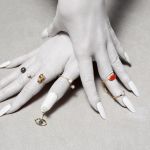
Collaboration is the sincerest form of flattery
The eternal battle between big houses and emerging brands
October 7th, 2016
Last week a controversial article appeared on Hypebae has given rise to much debate. In short, it was an open letter from jewelry designer Jules Kim addressed to all brands who copy her works.
Jules Kim launched her brand Bijules in 2003 and during thirteen years of career her name has gained a relevant visibility and success, also conquering celebs like Gwen Stefani. I'm sure you have noticed her well-known designs for once. Or better, you surely have seen one of her creations, but maybe her name wasn't on it. And so, this brings us to the point of the issue.

Jules Kim via Refinery29
The designer's letter concerns the problem that her works, now very popular, have been copied by fashion companies again and again, without ever citing the source of inspiration.
Delfina Delettrez's Dot Rings are a very good example. Now a trademark of the designer, they are actually inspired by Bijules's Le Grimpeur Two-Gradient Stackable model. But the list is long and it involves also “robberies” by Gabriela Artigas, Kismet and Amanda Marmer, including fast-fashion stores like Topshop, Zara and Forever 21. Even Gucci seems to have copied Jules Kim's works: the Nail Rings from the SS16 collection are probably an imitation of the jewelry designer's Sleek Nail Rings, fact that has meant polemics and a lawsuit for Gucci.
We are facing a real intellectual property theft, a robbery against the independent brands' creativity, who fight the luxury giants on no-equal terms.

Bijules
However, the most interesting point of the letter is not the dispute about the creative appropriation or the eternal battle between emerging brands and big names of fashion. No, the aspect we have to consider is the proposal the designer launched to the big companies, which is the possibility to establish an open dialogue between the two factions.
Jules Kim admits that the fact to be copied is certainly a good thing, because it means that her designs are largely loved and she has been able to create a successful trend that could last in time.
However, the levels of imitation are no longer acceptable: when the copy puts the original in the shadows, making all the designers' efforts to create something very personal and distinctive wasted, well, it's time to react.

Delfina Delettrez designs
So, the answer could be a collaboration between new designers and big companies, which look at their creations as very good products to sell and they have all the possibilities to launch them to the mass audience successfully. This system could make everybody happy: the companies would still have new designs to sell, young creators would have the possibility to reach greater visibility and to work with big names of the luxury trade, and customers would be aware of who is actually behind their purchases.
Unfortunately, this way doesn't seem to meet the needs of big companies. Even if they don't have to face high risks like the new designers, they prefer to copy emerging trends and original works and sell them as theirs. What a shame, because this proposal could be very profitable and ethically correct.
It actually makes me think of the latest Vetements' multi-collaboration collection, which has given life (again) to a new revolution, following the idea of working with the experts of a specific sector or who made a certain design first. The example of Vetements is probably too strong, but the concept is the same: give people who propose new ideas the fair value (and glory) they deserve.

























.webp)










.jpg)


















.webp)